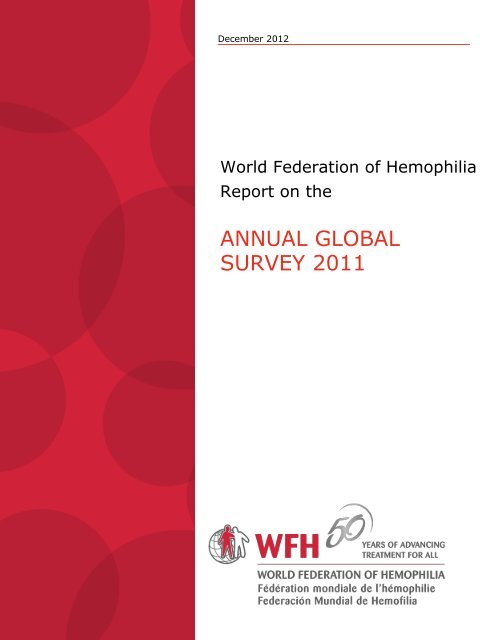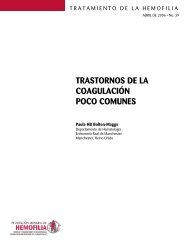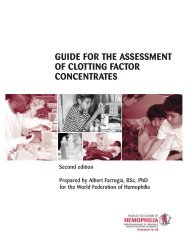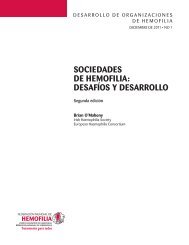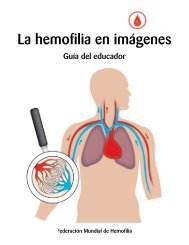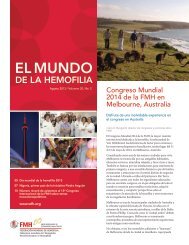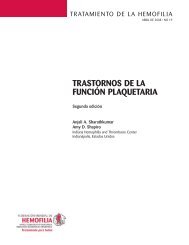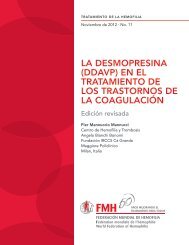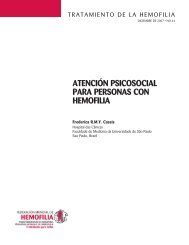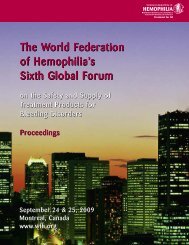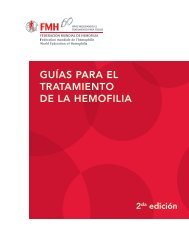ANNUAL GLOBAL SURVEY 2011 - World Federation of Hemophilia
ANNUAL GLOBAL SURVEY 2011 - World Federation of Hemophilia
ANNUAL GLOBAL SURVEY 2011 - World Federation of Hemophilia
You also want an ePaper? Increase the reach of your titles
YUMPU automatically turns print PDFs into web optimized ePapers that Google loves.
December 2012<strong>World</strong> <strong>Federation</strong> <strong>of</strong> <strong>Hemophilia</strong>Report on the<strong>ANNUAL</strong> <strong>GLOBAL</strong><strong>SURVEY</strong> <strong>2011</strong>
Report on the Annual Global Survey <strong>2011</strong> is published by the <strong>World</strong> <strong>Federation</strong> <strong>of</strong> <strong>Hemophilia</strong>.All data are provisional.© <strong>World</strong> <strong>Federation</strong> <strong>of</strong> <strong>Hemophilia</strong>, 2013To obtain permission to reprint, redistribute, or translate this publication, please contact theCommunications Department at the address below.When this data is used in publications or other research the <strong>World</strong> <strong>Federation</strong> <strong>of</strong> <strong>Hemophilia</strong> must becredited. We encourage researchers to contact us in the event they use the Global Survey data.Please note: This material is intended for general information only. The <strong>World</strong> <strong>Federation</strong> <strong>of</strong> <strong>Hemophilia</strong>does not endorse particular treatment products or manufacturers; any reference to a product name is notan endorsement by the <strong>World</strong> <strong>Federation</strong> <strong>of</strong> <strong>Hemophilia</strong>. The WFH is not a regulatory agency and cannotmake recommendations relating to safety <strong>of</strong> manufacturing <strong>of</strong> specific blood products. Forrecommendations <strong>of</strong> a particular product, the regulatory authority in a particular country must make thesejudgments based on domestic legislation, national health policies and clinical best-practices.<strong>World</strong> <strong>Federation</strong> <strong>of</strong> <strong>Hemophilia</strong>1425, boul. René-Lévesque Ouest, bureau 1010Montréal, Québec H3G 1T7CanadaTel. (514) 875-7944Fax: (514) 875-8916E-mail: wfh@wfh.orgWebsite: www.wfh.org
<strong>World</strong> <strong>Federation</strong> <strong>of</strong> <strong>Hemophilia</strong> Global Survey <strong>2011</strong>Introduction to the Report on the WFH Global Survey <strong>2011</strong>Report on the Annual Global Survey <strong>2011</strong> includes selected demographic and other data on people with hemophilia(PWH), von Willebrand disease (VWD), other rare factor deficiencies, and inherited platelet disorders throughoutthe world. The purpose <strong>of</strong> this report is to provide useful information to hemophilia organizations, hemophiliatreatment centres (HTCs), and health <strong>of</strong>ficials involved in efforts to reduce or prevent complications <strong>of</strong> bleedingdisorders in order to assist with program planning.MethodologyIn 1998, the <strong>World</strong> <strong>Federation</strong> <strong>of</strong> <strong>Hemophilia</strong> (WFH) began collecting information on hemophilia care throughoutthe world. This survey, called the WFH Global Survey, collects basic demographic information, data on resources <strong>of</strong>care and treatment products, and information on the prevalence (the percentage <strong>of</strong> the population affected) <strong>of</strong>infectious complications such as HIV and hepatitis C (HCV). The WFH compiled the first survey report in 1999.Each year questionnaires are sent to national hemophilia associations linked with the WFH with the request thatthey in turn work with physicians or health <strong>of</strong>ficials, as necessary, to complete the survey. The WFH reviewscompleted questionnaires for inconsistencies, which are clarified where possible by communicating directly with theparticipating organization. The <strong>2011</strong> survey is the twelfth WFH survey. This report uses data for the years 2007,2008, 2009, 2010 and <strong>2011</strong>. Not all <strong>of</strong> our members are able to report every year. A list <strong>of</strong> participating countries andtheir data year can be found on page 10. The survey includes data on more than 265,000 people with hemophilia,von Willebrand disease and other bleeding disorders in 108 countries. Data from the WFH questionnaire aresupplemented with data from other sources in order to provide a general socio-economic picture <strong>of</strong> each countrysurveyed. The survey questionnaire is included at the end <strong>of</strong> this report.Comments on the graphsThe graph showing the increase over time in patients identified contains data from the history <strong>of</strong> the Global Survey.This graph was created using aggregated numbers to demonstrate the increases in patients identified over time. If acountry reported data one year and not the next, the older data were used on the assumption that the number <strong>of</strong>patients did not change substantially from one year to the next. For all the graphs, answers were not always availablefor all questions. In such cases, the analysis was done using only data from countries that responded, with thenumber <strong>of</strong> respondents as the denominator.Comments on data collectionParticipation in the survey is voluntary. Although these data are self-reported, fairly consistent information onhemophilia care has been obtained from countries with similar economic capacities, validating its use for programplanning. Countries that are part <strong>of</strong> the WFH’s Global Alliance for Progress (GAP) program (Azerbaijan, Belarus,Ecuador, Jordan, Lebanon, Mexico, Russia, Thailand, Tunisia, China, and Syria) report more frequently than onceper year, in cases where a <strong>2011</strong> survey form was not completed other WFH data was used. Some countries are onlyable to provide detailed data on gender, age, inhibitors and HIV/HCV infection for a limited subset <strong>of</strong> patients, forexample they may know the total number <strong>of</strong> people with hemophilia in the country but have age and gender datafrom just one treatment centre. This report provides information on the annual usage <strong>of</strong> treatment products for <strong>2011</strong>only. It includes only those countries where the national hemophilia organization provided information. Quantitiesreported used were not independently verified except when the WFH has data on humanitarian donations in <strong>2011</strong>.The amounts reported may only be factor bought through government or other sources. Not all national hemophiliaorganizations are able to report on all product used in their country.1 WFH Global Survey <strong>2011</strong>
<strong>World</strong> <strong>Federation</strong> <strong>of</strong> <strong>Hemophilia</strong> Global Survey <strong>2011</strong><strong>2011</strong> WFH Global Survey summaryDemographicsNumber <strong>of</strong> countries in this survey 108Percentage <strong>of</strong> world population covered by countries in <strong>2011</strong> survey report 90.6%Number <strong>of</strong> people identified with hemophilia* 167,110Number <strong>of</strong> people identified with VWD 69,729Number <strong>of</strong> people identified with other bleeding disorders 31,191Total number <strong>of</strong> people with bleeding disorders identified 268,030Number <strong>of</strong> people with hemophilia A 134,354Number <strong>of</strong> people with hemophilia B 26,821Number <strong>of</strong> hemophilia A patients with clinically identified inhibitors 3387Number <strong>of</strong> hemophilia B patients with clinically identified inhibitors 183* Please note that the total number <strong>of</strong> patients identified with hemophilia may be higher than the number <strong>of</strong> patientsidentified with specific types <strong>of</strong> hemophilia because some patients in some countries are known to have bleedingdisorders but the specific diagnosis has not been reported.Factor usageMean global per capita factor VIII usage 2.20 IU 68 countries reportingMedian global per capita factor VIII usage 1.02 IU 68 countries reportingMean global per capita factor IX usage 0.36 IU 61 countries reportingMedian global per capita factor IX usage 0.20 IU 61 countries reportingTotal reported annual global consumption <strong>of</strong> factor VIIIconcentratesTotal reported annual global consumption <strong>of</strong> factor IXconcentrates4,583,364,827 IU 68 countries reporting641,739,140 IU 61 countries reportingThe average per capita and total consumption figures reported this year cannot be directly compared to the figuresfrom other survey years as the group <strong>of</strong> countries reporting factor usage changes from year to year. To illustrate, if alarge country using large amounts <strong>of</strong> factor or a large country using very little factor, reports one year and not thenext, then this will have a significant effect on the mean and median from year to year.The chart below shows average per capita factor use for the countries that reported in both the 2010 and <strong>2011</strong>surveys.2010 <strong>2011</strong>Mean global per capita factor VIII usage 1.37 IU 1.60 IU 50 countries reportingMedian global per capita factor VIII usage 2.39 IU 2.50 IU 50 countries reportingMean global per capita factor IX usage 0.17 IU 0.22 IU 45 countries reportingMedian global per capita factor IX usage 0.38 IU 0.39 IU 45 countries reporting3 WFH Global Survey <strong>2011</strong>
<strong>World</strong> <strong>Federation</strong> <strong>of</strong> <strong>Hemophilia</strong> Global Survey <strong>2011</strong>A. Identified patients – all disorders300,000250,000200,000150,000100,00050,00001999 2000 2001 2002 2003 2004 2005 2006 2007 2008 2009 2010 <strong>2011</strong><strong>Hemophilia</strong> A & B von Willebrand disease Other bleeding disordersThis graph showing the increase over time in patients identified contains data from the history <strong>of</strong> theGlobal Survey. This graph was created using aggregated numbers to demonstrate the increases inpatients identified over time. If a country reported data one year and not the next, the older datawere used on the assumption that the number <strong>of</strong> patients did not change substantially from one yearto the next. Collection <strong>of</strong> data for other bleeding disorders (rare factor deficiencies, and inheritedplatelet disorders) began in 2004. For all the graphs, answers are not always available for allquestions. In such cases, the graph was created using only data from countries that responded, withthe number <strong>of</strong> respondents as the denominator.WFH Global Survey <strong>2011</strong> 4
<strong>World</strong> <strong>Federation</strong> <strong>of</strong> <strong>Hemophilia</strong> Global Survey <strong>2011</strong>B1. Average global factor VIII use per capita based on <strong>World</strong> Bank rankings. Categories arebased on the rankings for 2010.765Mean per capitaMedian per capitaIU per capita43210Upper Upper middle Lower middle Lower<strong>World</strong> Bank income rankingB2. Average global factor VIII use per patient based on <strong>World</strong> Bank rankings.90,00080,000IU per patient70,00060,00050,00040,00030,000Mean per patientMedian per patient20,00010,0000Upper Upper middle Lower middle Lower<strong>World</strong> Bank income ranking(Gross national income per capita in US dollars: lower income, $0-$995; lower middleincome, $996 - $3,945; upper middle income, $3,946 - $12,195; and high income, $12,196or more.)5 WFH Global Survey <strong>2011</strong>
<strong>World</strong> <strong>Federation</strong> <strong>of</strong> <strong>Hemophilia</strong> Global Survey <strong>2011</strong>C1. Mean per capita factor use in <strong>2011</strong> – regional and GNI comparisons <strong>of</strong> IU/totalpopulation: AfricaGNID C BAlgeriaMauritiusSouth AfricaCameroonCote d'IvoireGhanaLesothoNigeriaSenegalSudanUgandaEthiopiaZimbabwe0.090.030.090.000.010.000.010.000.000.000.050.000.000.000.020.010.130.000.000.000.010.050.400.811.24FIXFVIII0.00 1.00 2.00Economic category based on <strong>World</strong> Bank rankings. Categories are based on the rankings for 2010.(GNI in US dollars: D lower income, $0-$995; C lower middle income, $996 - $3,945; B upper middleincome, $3,946 - $12,195; and A high income, $12,196 or more.)PLEASE NOTE: The X axis showing the number <strong>of</strong> IU/capita is different in each graph. The orange lineindicates 1 IU per capita <strong>of</strong> factor VIII. The WFH has established that one international unit (IU) <strong>of</strong>FVIII clotting factor concentrate per capita should be the target minimum for countries wishing toachieve optimal survival for the hemophilia population. Higher levels would be required to preservejoint function or achieve a quality <strong>of</strong> life equivalent to an individual without hemophilia. Please notethe orange line does not apply to factor IX. Where there is no number for factor IX, no number wasreported. Only countries that completed the <strong>2011</strong> questionnaire are included in these charts.WFH Global Survey <strong>2011</strong> 6
<strong>World</strong> <strong>Federation</strong> <strong>of</strong> <strong>Hemophilia</strong> Global Survey <strong>2011</strong>C2. Mean per capita factor use in <strong>2011</strong> – regional and GNI comparisons <strong>of</strong> IU/totalpopulation: AmericasC B AGNICanadaArgentinaBrazilColombiaCosta RicaCubaDominican RepublicMexicoPanamaVenezuelaBelizeBoliviaHondurasNicaragua0.230.280.250.020.260.030.090.110.190.180.220.360.530.010.050.330.880.710.521.251.452.042.492.242.62FIX6.06FVIII0.00 1.00 2.00 3.00 4.00 5.00 6.00 7.00C3. Mean per capita factor use in <strong>2011</strong> – regional and GNI comparisons <strong>of</strong> IU/totalpopulation: Eastern MediterraneanC B AGNISaudi ArabiaIranLebanonEgyptIraqPakistanTunisia0.060.230.200.000.190.170.000.010.100.750.760.63Economic category based on <strong>World</strong> Bank rankings. Categories are based on the rankings for 2010.(GNI in US dollars: D lower income, $0-$995; C lower middle income, $996 - $3,945; B upper middleincome, $3,946 - $12,195; and A high income, $12,196 or more.)PLEASE NOTE: The X axis showing the number <strong>of</strong> IU/capita is different in each graph. The orange lineindicates 1 IU per capita <strong>of</strong> factor VIII. The WFH has established that one international unit (IU) <strong>of</strong>FVIII clotting factor concentrate per capita should be the target minimum for countries wishing toachieve optimal survival for the hemophilia population. Higher levels would be required to preservejoint function or achieve a quality <strong>of</strong> life equivalent to an individual without hemophilia. Please notethe orange line does not apply to factor IX. Where there is no number for factor IX no number wasreported. Only countries that completed the <strong>2011</strong> questionnaire are included in these charts.1.512.57FIXFVIII0.00 1.00 2.00 3.007 WFH Global Survey <strong>2011</strong>
<strong>World</strong> <strong>Federation</strong> <strong>of</strong> <strong>Hemophilia</strong> Global Survey <strong>2011</strong>C4. Mean per capita factor use in <strong>2011</strong> – regional and GNI comparisons <strong>of</strong> IU/totalpopulation: EuropeGNIC B ABelgium6.360.54Czech Republic4.00Denmark1.256.17Finland0.976.33France1.046.28Germany1.006.91Greece0.603.61Hungary0.496.36Ireland2.668.09Latvia0.221.70Poland0.524.73Portugal0.634.07Slovak Republic0.555.66FIXSlovenia0.366.17Switzerland0.704.17FVIIIUnited Kingdom7.301.26Albania0.37Azerbaijan0.221.68Bulgaria0.132.14Lithuania0.623.37Romania 0.52Russia0.494.74Serbia0.101.22Turkey0.291.92Moldova0.010.560.00Uzbekistan0.020.00 1.00 2.00 3.00 4.00 5.00 6.00 7.00 8.00 9.00WFH Global Survey <strong>2011</strong> 8
<strong>World</strong> <strong>Federation</strong> <strong>of</strong> <strong>Hemophilia</strong> Global Survey <strong>2011</strong>C5. Mean per capita factor use in <strong>2011</strong> – regional and GNI comparisons <strong>of</strong> IU/totalpopulation: South-East AsiaGNIIndia0.000.03D CThailandBangladesh0.070.000.01FIXFVIII0.00 1.00C6. Mean per capita factor use in <strong>2011</strong> – regional and GNI comparisons <strong>of</strong> IU/totalpopulation: Western PacificGNIAustralia1.167.23C AKorea, Republic <strong>of</strong>New ZealandPhilippines0.010.030.540.803.145.75FIXFVIIIViet Nam0.000.060.00 1.00 2.00 3.00 4.00 5.00 6.00 7.00 8.00Economic category based on <strong>World</strong> Bank rankings. Categories are based on the rankings for 2010.(GNI in US dollars: D lower income, $0-$995; C lower middle income, $996 - $3,945; B upper middleincome, $3,946 - $12,195; and A high income, $12,196 or more.)PLEASE NOTE: The X axis showing the number <strong>of</strong> IU/capita is different in each graph. The orange lineindicates 1 IU per capita <strong>of</strong> factor VIII. The WFH has established that one international unit (IU) <strong>of</strong>FVIII clotting factor concentrate per capita should be the target minimum for countries wishing toachieve optimal survival for the hemophilia population. Higher levels would be required to preservejoint function or achieve a quality <strong>of</strong> life equivalent to an individual without hemophilia. Please notethe orange line does not apply to factor IX. Where there is no number for factor IX no number wasreported. Only countries that completed the <strong>2011</strong> questionnaire are included in these charts.9 WFH Global Survey <strong>2011</strong>
<strong>World</strong> <strong>Federation</strong> <strong>of</strong> <strong>Hemophilia</strong> Global Survey <strong>2011</strong>Countries included in the <strong>2011</strong> WFH Global Survey ReportPlease note: the year indicates the year the submitted data applies to. Not all <strong>of</strong> our members areable to submit data every year. For the <strong>2011</strong> survey report, 83 countries submitted data for <strong>2011</strong>.The data used from other years is as follows. 2010: 13 countries, 2009: 6 countries, 2008: 2countries, 2007: 4 countries. For countries that did not complete a <strong>2011</strong> survey form but are part<strong>of</strong> the WFH GAP program, WFH data on the total number <strong>of</strong> patients identified and factor use in<strong>2011</strong> was used. All other data are from the year indicated. 2007 to 2010 surveys are only used forreporting the number <strong>of</strong> patients identified – all other numbers in this report are from <strong>2011</strong> only.Albania <strong>2011</strong>Algeria <strong>2011</strong>Argentina <strong>2011</strong>Armenia 2009Australia <strong>2011</strong>Austria <strong>2011</strong>Azerbaijan <strong>2011</strong>Bahrain <strong>2011</strong>Bangladesh <strong>2011</strong>Belarus 2010Belgium <strong>2011</strong>Belize <strong>2011</strong>Bolivia <strong>2011</strong>Brazil <strong>2011</strong>Bulgaria <strong>2011</strong>Cambodia <strong>2011</strong>Cameroon <strong>2011</strong>Canada <strong>2011</strong>Chile 2009China <strong>2011</strong>Colombia <strong>2011</strong>Costa Rica <strong>2011</strong>Cote d'Ivoire <strong>2011</strong>Croatia 2007Cuba <strong>2011</strong>Czech Republic <strong>2011</strong>Denmark <strong>2011</strong>Dominican Republic <strong>2011</strong>Ecuador <strong>2011</strong>Egypt <strong>2011</strong>Eritrea <strong>2011</strong>Ethiopia <strong>2011</strong>Finland <strong>2011</strong>France <strong>2011</strong>Georgia 2010Germany <strong>2011</strong>Ghana <strong>2011</strong>Greece <strong>2011</strong>Guatemala 2010Honduras <strong>2011</strong>Hungary <strong>2011</strong>Iceland 2007India <strong>2011</strong>Indonesia 2010Iran <strong>2011</strong>Iraq <strong>2011</strong>Ireland <strong>2011</strong>Israel 2010Italy 2007Japan <strong>2011</strong>Jordan <strong>2011</strong>Kazakhstan 2008Kenya <strong>2011</strong>Korea, Republic <strong>of</strong> <strong>2011</strong>Kuwait <strong>2011</strong>Kyrgyzstan 2010Latvia <strong>2011</strong>Lebanon <strong>2011</strong>Lesotho <strong>2011</strong>Lithuania <strong>2011</strong>Macedonia <strong>2011</strong>Malaysia 2010Mauritius <strong>2011</strong>Mexico <strong>2011</strong>Moldova <strong>2011</strong>Mongolia 2010Nepal <strong>2011</strong>Netherlands <strong>2011</strong>New Zealand <strong>2011</strong>Nicaragua <strong>2011</strong>Nigeria <strong>2011</strong>Norway 2008Oman 2010Pakistan <strong>2011</strong>Palestine 2010Panama <strong>2011</strong>Paraguay 2009Peru 2010Philippines <strong>2011</strong>Poland <strong>2011</strong>Portugal <strong>2011</strong>Romania <strong>2011</strong>Russia <strong>2011</strong>Saudi Arabia <strong>2011</strong>Senegal <strong>2011</strong>Serbia <strong>2011</strong>Slovak Republic <strong>2011</strong>Slovenia <strong>2011</strong>South Africa <strong>2011</strong>Spain <strong>2011</strong>Sri Lanka 2010Sudan <strong>2011</strong>Sweden 2009Switzerland <strong>2011</strong>Syria 2009Tanzania <strong>2011</strong>Thailand <strong>2011</strong>Tunisia <strong>2011</strong>Turkey <strong>2011</strong>Uganda <strong>2011</strong>Ukraine 2007United Kingdom <strong>2011</strong>United States 2010Uruguay 2009Uzbekistan <strong>2011</strong>Venezuela <strong>2011</strong>Viet Nam <strong>2011</strong>Zimbabwe <strong>2011</strong>WFH Global Survey <strong>2011</strong> 10
<strong>World</strong> <strong>Federation</strong> <strong>of</strong> <strong>Hemophilia</strong> Global Survey <strong>2011</strong>Population statistics(NOTE: In all <strong>of</strong> the population charts a 0 indicates that the member organization reported thenumber zero, a blank space indicates that no number was reported, “Not known” means that themember organization reported that they do not know the answer. Countries in BOLD reporteddata for <strong>2011</strong>. For countries that did not report population statistics for <strong>2011</strong> but did report duringthe years 2007-2010, we used the most recent number <strong>of</strong> patients reported. 2007 to 2010surveys are only used for reporting the number <strong>of</strong> patients identified – all other numbers in thisreport are from <strong>2011</strong> only.)CountryPopulationPeoplewithhemophiliaPeople withvonWillebranddiseasePeople withother bleedingdisordersAlbania 3,215,988 292 2 Not knownAlgeria 35,980,193 1,935 85 119Argentina 40,764,561 2,133 355 Not knownArmenia 3,100,236 208 10 10Australia 22,620,600 2,628 1,966 666Austria 8,419,000 645 37 35Azerbaijan 9,168,000 1,163 200 80Bahrain 1,323,535 38 40 13Bangladesh 150,493,658 543 0 8Belarus 9,473,000 745 171 45Belgium 11,008,000 1,159 1,467 302Belize 356,600 15 Not known Not knownBolivia 10,088,108 96 2 1Brazil 196,655,014 10,558 4,937 1,855Bulgaria 7,476,000 618 90 33Cambodia 14,305,183 75 1 2Cameroon 20,030,362 102 1 0Canada 34,482,779 3,380 3,563 1,460Chile 17,269,525 1,252China 1,344,130,000 10,182 52 46Colombia 46,927,125 1,963 229 161Costa Rica 4,726,575 200 66 28Cote d'Ivoire 20,152,894 59 2 3Croatia 4,407,000 477 282 139Cuba 11,253,665 407 139 2,224Czech Republic 10,546,000 990 400 Not knownDenmark 5,574,000 477 341 87DominicanRepublic 10,056,181 257 71 123Ecuador 14,666,055 479 89 811 WFH Global Survey <strong>2011</strong>
<strong>World</strong> <strong>Federation</strong> <strong>of</strong> <strong>Hemophilia</strong> Global Survey <strong>2011</strong>CountryPopulationPeoplewithhemophiliaPeople withvonWillebranddiseasePeople withother bleedingdisordersEgypt 82,536,770 4,829 474 1,037Eritrea 5,415,280 60 Not known Not knownEthiopia 84,734,262 56 20 0Finland 5,387,000 433 3,009 42France 65,436,552 5,735 1,330 375Georgia 4,486,000 256 22 10Germany 81,726,000 4,654 4,447Ghana 24965816 51 1 Not knownGreece 11,304,000 899 792 185Guatemala 14,757,316 114 18 2Honduras 7,754,687 203 3Hungary 9,971,000Iceland 319,000 64 96India 1,241,491,960 11,580 1,685 1,353Indonesia 242,325,638 1,388 Not known Not knownIran 74,798,599 5,318 1,029 2,182Iraq 32,961,959 944 215 216Ireland 4,487,000 739 817 1,619Israel 7,765,700 540 4 1Italy 60,770,000 3,270 1,650 700Japan 127,817,277 5,446 984 410Jordan 6,181,000 332 215 231Kazakhstan 16,558,459 1,360 460 108Kenya 41,609,728 613 18 16Korea, Republic <strong>of</strong> 49,779,000 1,908 93 102Kuwait 2,818,042 Not known Not known Not knownKyrgyzstan 5,507,000 320 10Latvia 2,220,000 143 102 Not knownLebanon 4,259,405 163 107 65Lesotho 2,193,843 22 Not known Not knownLithuania 3,203,000 166 302 15Macedonia 2,063,893 315 Not known Not knownMalaysia 28,859,154 1,188 464 346Mauritius 1,286,051 44 1 7Mexico 114,793,341 4,632 214 25Moldova 3,559,000 234 6 3WFH Global Survey <strong>2011</strong> 12
<strong>World</strong> <strong>Federation</strong> <strong>of</strong> <strong>Hemophilia</strong> Global Survey <strong>2011</strong>CountryPopulationPeoplewithhemophiliaPeople withvonWillebranddiseasePeople withother bleedingdisordersMongolia 2,800,114 75 4 Not knownNepal 30,485,798 392 1 13Netherlands 16,696,000 1,397 2,500 65New Zealand 4,405,200 416 186 23Nicaragua 5,869,859 247 54 7Nigeria 162,470,737 132 6Norway 4,952,000 397 858 37Oman 2,846,145 97 281 271Pakistan 176,745,364 1,589 391 314Palestine 4,019,433 135 10 63Panama 3,571,185 265 408 29Paraguay 6,277,000 448 1 1Peru 29,399,817 743 144 17Philippines 94,852,030 1,131 29Poland 38,216,000 2,734 1,206 464Portugal 10,637,000 641 48 23Romania 21,390,000 1,610 348 9Russia 141,930,000 5,421 1,254 954Saudi Arabia 28,082,541 326 75 36Senegal 12,767,556 116 4 6Serbia 7,261,000 469 210 17Slovak Republic 5,440,000 572 532Slovenia 2,052,000 204 162 96South Africa 50,586,757 1,996 591 214Spain 46,235,000 1,953 710 211Sri Lanka 20,869,000 664 Not known Not knownSudan 34,318,385 663 171 170Sweden 9,453,000 1,020 1,538Switzerland 7,907,000 701 136 70Syria 20,820,311 465 30 16Tanzania 46,218,486 56 1Thailand 69,518,555 1,260 69 53Tunisia 10,673,800 363 82Turkey 73,639,596 4,651 728 1,086Uganda 34,509,205 15 Not known Not knownUkraine 45,706,100 2,60013 WFH Global Survey <strong>2011</strong>
<strong>World</strong> <strong>Federation</strong> <strong>of</strong> <strong>Hemophilia</strong> Global Survey <strong>2011</strong>CountryPopulationPeoplewithhemophiliaPeople withvonWillebranddiseasePeople withother bleedingdisordersUnited Kingdom 62,641,000 6,575 9,301 7,583United States 311,591,917 17,485 13,239 1,772Uruguay 3,368,595 236 316 11Uzbekistan 29,341,200 1,291 91 25Venezuela 29,278,000 2,144 752 830Viet Nam 87,840,000 2,000 76 207Zimbabwe 12,754,378 320 Not known Not knownTotal 6,365,209,633 167,110 69,729 31,191WFH Global Survey <strong>2011</strong> 14
<strong>World</strong> <strong>Federation</strong> <strong>of</strong> <strong>Hemophilia</strong> Global Survey <strong>2011</strong>Distribution <strong>of</strong> reported bleeding disorders by country(NOTE: In all <strong>of</strong> the population charts a 0 indicates that the member organization reported thenumber zero, a blank space indicates that no number was reported. Countries in BOLDreported data for <strong>2011</strong>.)Country<strong>Hemophilia</strong> A<strong>Hemophilia</strong> B<strong>Hemophilia</strong> typeunknownvWDAlbania 254 38 2 1 1FIFIIAlgeria 1,540 356 85 17 2 10 15 49 4 3 5 4FVFV+VIIIFVIIFXFXIFXIIIBleeding Dis.:Type UnknownGlanzmann’s.Bernard SoulierPlateletdisorders:Other/UnknownArgentina 1,873 260 158 355 21Armenia 184 18 10 5 2 2 1 1Australia 2,109 517 1,966 13 53 12 151 17 196 10 1 180Austria 546 99 0 37 0 0 5 1 12 3 7 3 0 0 0 0Azerbaijan 1,065 98 200 5 11 12 10 3 2 37 6Bahrain 34 4 0 40 0 2 0 0 2 10 7 0Bangladesh 471 72 6 0 1 1Belarus 452 94 171 14 1 26 4Belgium 941 212 3 1,467 1 1 20 68 3 90 2 62 19 4Belize 10 5Bolivia 84 10 1 131Brazil 8,839 1,719 4,937 45 11 91 14 382 64 112 39 777 154 33Bulgaria 560 68 90 1 5 3 2 3 8 11Cambodia 64 11 1 1 1 2Cameroon 99 3 0 1 0 0 0 0 0 0 0 0 0 0 0Canada 2,722 658 3,563 78 11 50 4 246 21 322 51 80 53 28 553Chile 1,068 184China 8,921 1,261 52 2 0 3 1 8 2 15 2 169 0 0 0Colombia 1,488 308 164 229 15 9 9 2 17 1 11 7 37 5 5 25Costa Rica 169 31 66 1 1 12 5 5 4Coted'Ivoire 54 5 2 2 1Croatia 385 92 0 282 6 0 12 3 48 3 19 7 3 17Cuba 337 70 0 139 2 1 1 0 1 0 12 7 8 2 0 2,190CzechRepublic 858 132 400Denmark 384 91 341 1 1 2 4 7 5 11 8 7 43DominicanRepublic 220 37 68 7 22 3 3 1Ecuador 396 83 88 1 1 1 1 3 1Egypt 3,861 967 474 126 8 154 6 86 99 91 29 21 410 8Eritrea 54 6Ethiopia 48 8 61 20Finland 337 96 3,009 3 1 5 10 7 2 13France 4,704 1,031 0 1,330 38 1 38 8 118 18 129 25 015 WFH Global Survey <strong>2011</strong>
<strong>World</strong> <strong>Federation</strong> <strong>of</strong> <strong>Hemophilia</strong> Global Survey <strong>2011</strong>Country<strong>Hemophilia</strong> A<strong>Hemophilia</strong> B<strong>Hemophilia</strong> typeunknownvWDFIFIIFVFV+VIIIFVIIFXFXIFXIIIBleeding Dis.:Type UnknownGlanzmann’s.Bernard SoulierPlateletdisorders:Other/UnknownGeorgia 218 38 10 22 2 1 6Germany 3,957 697 4,447Ghana 50 1 1Greece 752 147 792 16 0 13 0 57 6 61 9 13 10Guatemala 108 6 18 1 1Honduras 183 19 3 3 1 1Iceland 63 2 0 96 0 12India 11,586 1,687 879 354 8 4 20 1 22 24 27 55 51Indonesia 334 48 1,006Iran 4,386 932 0 1,029 111 21 129 173 375 141 121 183 157 427 75 263Iraq 706 238 215 34 1 1 1 53 11 8 20 87Ireland 539 200 0 817 0 0 100 0 82 85 142 6 416 27 3 243Israel 458 92 21Italy 2,697 573 21 1,650 49 14 73 23 308 54 156 21 45 115Japan 4,475 971 984 59 7 29 9 64 19 28 57Jordan 253 79 215 4 12 43 22 38 11 100 1Kazakhstan 1,036 324 460Kenya 412 57 18 16Korea,Republic <strong>of</strong> 1,553 355 0 93 6 0 4 8 31 2 14 5 32Kyrgyzstan 209 17 84 10 5 2Latvia 118 25 102 2Lebanon 130 33 0 107 34 0 9 0 4 5 5 2 0 1 0 5Lithuania 146 20 302 11 2 2Macedonia 210 105Malaysia 1,008 180 464 4 2 18 1 43 14 40 13 42 0 35Mauritius 40 4 1 3 1 1 2Mexico 3,747 561 349 214 2 1 13 4 2 2 1Moldova 6 1 4Mongolia 62 13 4Nepal 345 47 1 1 1 9 2Netherlands 1,195 202 2,500NewZealand 341 76 186 0 0 0 0 8 1 2 1 7 0 0 3Nicaragua 219 28 54 4 2 3Norway 301 96 0 3 2 0 23 0 0Oman 90 7 281 5 1 6 5 48 3 17 1 8 24 2 151Pakistan 1,376 313 0 393 16 1 23 9 32 16 3 36 172 92 10 2Palestine 107 28 10 12 2 11 36 2Panama 237 28 0 408 8 11 0 0 3 1 7Paraguay 434 14 1 1WFH Global Survey <strong>2011</strong> 16
<strong>World</strong> <strong>Federation</strong> <strong>of</strong> <strong>Hemophilia</strong> Global Survey <strong>2011</strong>Country<strong>Hemophilia</strong> A<strong>Hemophilia</strong> B<strong>Hemophilia</strong> typeunknownvWDFIFIIFVFV+VIIIFVIIFXFXIFXIIIBleeding Dis.:Type UnknownGlanzmann’s.Bernard SoulierPlateletdisorders:Other/UnknownPeru 577 103 63 144 0 0 1 0 8 0 5 1 0 1 0 0Philippines 945 145 41 29Poland 2,348 386 1,206 0 20 3 198 17 34 10 18 2 7Portugal 531 110 48 2 3 2 1 7 1 43 1 6Romania 1,415 195 15 348 1 2 5 1Russia 4,720 701 1,254 954SaudiArabia 260 66 0 75 0 2 3 1 6 1 9 13 0 66 2 0Senegal 108 8 4 1 3 2Serbia 400 69 210 1 1 5 5 4 1 1SlovakRepublic 498 74 532 73 0 58 2 580 24 48 3 10 15 16Slovenia 183 21 162 9 2 11 16 1 3SouthAfrica 1,685 311 591 7 0 42 5 18 9 30 7 16 24 50Spain 1,679 277 709 15 3 13 3 25 9 24 17 152 15Sri Lanka 498 137 29Sudan 562 101 171 17 1 26 19 11 28 66Switzerland 585 116 0 136 11 0 0 4 29 4 8 14Syria 252 48 30 5 2 3 2 1 3Tanzania 27 8 22Thailand 294 51 69 1 0 2 1 14 1 0 0 0Tunisia 293 70 0 81 24 1 14 6 31 6 12 15 6 62 8 5Turkey 3,926 725 728 15 25 401 103 16 80 389 16Uganda 7 6 3UnitedKingdom 5,424 1,151 9,301 175 11 141 23 730 188 2,030 60 110 62 1,376United States 13,276 4,209 13,239 123 48 163 730 89 504 115Uruguay 185 30 21 316 1 2 3 1 2 2 1 1Uzbekistan 1,194 97 92 1 2 7 8 25 8 15Venezuela 1,695 449 752 19 65 29 27 117 103 308 16 14 4 116Viet Nam 1,272 234 76 3 5 1 6 15 8 4 4 21 84 49Zimbabwe 303 16 1Total 134,354 26,821 2,936 66,007 1,196 244 1,420 385 5,357 1,317 4,759 1,054 4,026 1,884 325 5,66317 WFH Global Survey <strong>2011</strong>
<strong>World</strong> <strong>Federation</strong> <strong>of</strong> <strong>Hemophilia</strong> Global Survey <strong>2011</strong>Gender distributionsThis table provides the number <strong>of</strong> males and females with each bleeding disorder forthe countries that have that data.DisorderCountriesreportingTotal patientsidentified<strong>Hemophilia</strong> A 91 119,706 114,484 96 2,663 2 2,559 2<strong>Hemophilia</strong> B 91 24,283 22,794 94 877 4 612 3<strong>Hemophilia</strong> type unknown 91 1,825 1,650 90 114 6 61 3Von Willebrand Disorder 67 56,874 22,596 40 33,494 59 784 1Factor I Deficiency 62 1,109 477 43 562 51 70 6Factor II Deficiency 62 230 119 52 107 47 4 2Factor V Deficiency 62 1,315 558 42 640 49 117 9Factor V+VIII Deficiency 62 352 200 57 151 43 1 0Factor VII Deficiency 62 4,914 2,474 50 2,385 49 55 1Factor X Deficiency 62 1,246 628 50 557 45 61 5Factor XI Deficiency 62 4,567 2,124 47 2,357 52 86 2Factor XIII Deficiency 62 1,007 598 59 390 39 19 2Bleeding Disorder: TypeUnknown 62 2,819 1,532 54 1,283 46 4 0Platelet disorders:Glanzmanns thrombasthenia 62 1,814 748 41 779 43 287 16Platelet disorders: BernardSoulier Syndrome 62 309 148 48 157 51 4 1Platelet disorders: other orunknown 62 5,491 2,111 38 3,380 62 0 0MalePercent maleFemalePercentfemaleGender notknownPercent notknownWFH Global Survey <strong>2011</strong> 18
<strong>World</strong> <strong>Federation</strong> <strong>of</strong> <strong>Hemophilia</strong> Global Survey <strong>2011</strong>Patients with current clinically significant inhibitors (Patients who do not respond to standardtreatment.)Country<strong>Hemophilia</strong> Aw/ clinicallyidentifiedinhibitors<strong>Hemophilia</strong> Bw/ clinicallyidentifiedinhibitorsCountry<strong>Hemophilia</strong> Aw/ clinicallyidentifiedinhibitors<strong>Hemophilia</strong> Bw/ clinicallyidentifiedinhibitorsAlgeria 35 0Argentina 278 10Australia 185 7Austria 26 2Azerbaijan 12Belize 0 0Bolivia 1Brazil 747 32Bulgaria 18 1Cameroon 3 0Canada 80 5China 77 3Colombia 66 5Costa Rica 19 0Coted'Ivoire 1 0Cuba 61 0CzechRepublic 12 2Denmark 11 1DominicanRepublic 3 0Egypt 25 1France 105 5Germany 68 12Greece 22 3Honduras 3Iran 239 7Iraq 20 1Ireland 8 2Japan 81 18Jordan 18 1Latvia 2 2Lebanon 6Lithuania 7 0Macedonia 2 1Mauritius 0 0Mexico 192 10NewZealand 30 0Nicaragua 1Pakistan 36 6Panama 13 0Philippines 10 2Poland 172 3Romania 102 3SaudiArabia 23 0Serbia 19 0SlovakRepublic 6 1Slovenia 2Spain 76 6Sudan 10 1Switzerland 7 1Turkey 116 14UnitedKingdom 187 12Uzbekistan 32Venezuela 85 3Viet Nam 24Zimbabwe 3Totals 3,387 18319 WFH Global Survey <strong>2011</strong>
<strong>World</strong> <strong>Federation</strong> <strong>of</strong> <strong>Hemophilia</strong> Global Survey <strong>2011</strong>Age distribution: hemophilia A (62 countries reported age data)Country 0-4 5-13 14-18 19-44 45+AgenotknownArgentina 86 271 213 848 390 65Australia 96 263 153 854 744Austria 10 72 50 255 159 0Azerbaijan 21 105 96 633 201Bahrain 3 6 5 20 0Bangladesh 20 141 112 173 25 0Belgium 34 119 82 331 370 5Belize 1 5 3 1Bolivia 17 23 13 14 6 11Brazil 542 1,647 1,116 4,214 1,271 49Cambodia 19 31 7 7Cameroon 40 14 30 13 2 0Canada 143 387 236 1,141 815China 473 1,975 1,003 4,275 486 709Colombia 28 140 146 482 141 551Costa Rica 7 44 17 78 23Cote d'Ivoire 4 14 19 13 4Cuba 13 43 44 191 46Czech Republic 34 98 61 222 174 269Egypt 1,360 186 65 301 33 1,916Eritrea 1 17 8 20 3 5Ethiopia 9 18 12 9 0France 260 768 465 2,020 1,191 0Ghana 10 18 17 5Greece 17 82 27 345 281Honduras 18 46 26 65 3 25India 467 2,000 1,194 3,614 602 3,709Iran 254 594 389 2,582 567Iraq 143 252 136 155 20Ireland 30 95 41 222 151 0Kenya 116 137 66 57 36Korea, Republic <strong>of</strong> 74 233 181 836 229Latvia 6 14 10 57 29 2Lebanon 10 25 11 65 17 2Mauritius 2 5 6 16 8Mexico 142 659 466 1,479 300 701Moldova 5 18 21 129 33Nepal 41 111 55 130 20WFH Global Survey <strong>2011</strong> 20
<strong>World</strong> <strong>Federation</strong> <strong>of</strong> <strong>Hemophilia</strong> Global Survey <strong>2011</strong>Country 0-4 5-13 14-18 19-44 45+Netherlands 16 226 117 360 434AgenotknownNew Zealand 20 64 37 134 70 16Nigeria 12 52 41 24 1Pakistan 247 505 363 222 28 44Panama 8 29 51 122 27Philippines 30 208 175 375 60 97Poland 45 175 136 1,237 755 0Portugal 11 64 23 230 158 45Romania 3 88 95 715 445 69Saudi Arabia 56 92 51 59Senegal 7 33 15 44 2 0Serbia 22 47 41 169 121Slovak Republic 21 44 29 226 178 0Slovenia 5 17 5 90 66South Africa 86 291 180 746 337 45Spain 35 153 92 782 471 146Sudan 55 181 109 200 17Switzerland 15 61 44 240 225 0Tanzania 2 5 5 3 1 11Turkey 190 904 572 1,734 498 28Uganda 3 4 3United Kingdom 341 716 467 2,092 1,805 3Uzbekistan 28 163 295 501 44 50Viet Nam 103 285 115 281 79 399Total 5,917 15,083 9,660 36,461 14,202 8,97221 WFH Global Survey <strong>2011</strong>
<strong>World</strong> <strong>Federation</strong> <strong>of</strong> <strong>Hemophilia</strong> Global Survey <strong>2011</strong>Age distribution: hemophilia B (62 countries reported age data)Country 0-4 5-13 14-18 19-44 45+WFH Global Survey <strong>2011</strong> 22AgenotknownArgentina 10 45 40 107 51 7Australia 13 71 27 236 170Austria 4 15 11 38 31 0Azerbaijan 5 18 17 36 22Bahrain 2 1 0 1 0 0Bangladesh 4 25 24 17 2 0Belgium 10 22 18 81 79 2Belize 2 1 2Bolivia 2 2 4 2Brazil 93 357 226 768 271 4Cambodia 5 2 2 2Cameroon 3 0 0 0 0 0Canada 30 65 72 280 211China 62 238 136 623 82 120Colombia 7 39 24 101 28 109Costa Rica 2 5 5 16 3Cote d'Ivoire 1 2 2Cuba 4 10 9 34 13Czech Republic 7 11 8 34 24 48Egypt 318 29 14 55 7 544Eritrea 2 3 1Ethiopia 2 2 1 3 0France 61 166 107 439 258 0Ghana 1Greece 2 13 1 73 58Honduras 6 6 7India 61 306 205 579 113 423Iran 31 121 74 573 133Iraq 36 77 53 53 19Ireland 9 11 16 97 67 0Kenya 3 15 29 28 2Korea, Republic <strong>of</strong> 20 72 41 174 48Latvia 1 3 1 16 3 1Lebanon 0 8 5 15 5 0Mauritius 2 2Mexico 21 90 82 230 53 85Moldova 1 1 2 8 5Nepal 5 18 4 18 3
<strong>World</strong> <strong>Federation</strong> <strong>of</strong> <strong>Hemophilia</strong> Global Survey <strong>2011</strong>Country 0-4 5-13 14-18 19-44 45+Netherlands 1 39 23 65 67AgenotknownNew Zealand 4 7 5 33 26 2Nigeria 1 1Pakistan 34 80 37 48 51 53Panama 2 7 5 13 1Philippines 2 32 27 57 13 14Poland 0 10 24 189 101 0Portugal 1 13 5 48 33 10Romania 2 11 13 80 80 9Saudi Arabia 4 26 4 28Senegal 5 2 1 0 0 0Serbia 7 12 5 32 13Slovak Republic 7 8 6 31 22 0Slovenia 1 1 11 8South Africa 19 58 28 132 70 4Spain 7 26 13 126 87 18Sudan 16 39 18 27 1Switzerland 0 8 14 53 41 0Tanzania 5 1 2Turkey 41 179 108 303 87 7Uganda 3 2United Kingdom 81 131 86 498 355 0Uzbekistan 3 18 13 56 4 16Viet Nam 13 17 26 67 16 95Total 1,086 2,602 1,731 6,652 2,837 1,57423 WFH Global Survey <strong>2011</strong>
<strong>World</strong> <strong>Federation</strong> <strong>of</strong> <strong>Hemophilia</strong> Global Survey <strong>2011</strong>Age distribution: VWD (56 countries reported age data)Country 0-4 5-13 14-18 19-44 45+Age notknownArgentina 0 8 16 179 99 53Australia 24 204 154 813 711Austria 0 6 4 18 8 0Azerbaijan 9 21 35 95 40Bahrain 0 5 31 4 0Bangladesh 0 0 0 0 0 0Belgium 30 261 120 606 439 11Bolivia 2Brazil 63 683 598 2,428 1,138 27Cambodia 1Cameroon 1 0 0 0 0 0Canada 49 408 349 1,700 1,057China 1 14 8 21 8Colombia 3 4 45 82 10 85Cote d'Ivoire 2Cuba 0 19 22 60 38Egypt 195 8 6 25 3 237Ethiopia 2 17 1France 36 234 108 527 425 0Ghana 1Greece 3 118 53 381 237Honduras 1 2India 11 59 30 121 11 122Iran 56 135 121 612 105Iraq 43 60 83 25 4Ireland 41 56 62 443 215 0Kenya 3 10 2 3Korea, Republic <strong>of</strong> 0 11 21 50 11Latvia 2 66 30 4Lebanon 4 27 17 46 10 3Mauritius 1Mexico 6 31 26 69 11 71Moldova 1 5Nepal 1Netherlands 150 210 300 650 675 500New Zealand 3 24 24 64 43 28Nigeria 2 4Pakistan 64 126 116 52 11 42WFH Global Survey <strong>2011</strong> 24
<strong>World</strong> <strong>Federation</strong> <strong>of</strong> <strong>Hemophilia</strong> Global Survey <strong>2011</strong>HIV and HCV infection (People currently living with HIV or HCV)CountryhemophiliaHIV+hemophiliaHCV+ vWD HIV+ vWD HCV+Algeria 2 No dataArgentina 63 623 No dataAustria 49 140 1 5Bahrain 0 0 0 0Bangladesh No data 1 No dataBolivia No data 2 No dataBulgaria 10 400 0Cameroon 0 0 0 0Canada 205 860 5 64China 32 211 No dataColombia 5 130 0 5Cote d'Ivoire 0 1 0 0Cuba 4 151 0 9Czech Republic 5 132 No dataDenmark 27 100 No dataDominican Republic 1 1 No dataEthiopia 4 3 No dataFinland 0 No dataFrance 455 1,709 14 146Germany 410 4Greece 64 309 1 27Honduras 3India 159Iran 150 3,000 0 20Iraq 0 200 0 60Ireland 36 141 0 11Japan 750 1,252 7Jordan 2 46 No dataKenya 22 0Korea, Republic <strong>of</strong> 17 0Lebanon 0 13 2Lesotho 0 0Lithuania 0Mauritius 0 8 0 1Mexico 24 121 1 2Nepal 5 0 0Netherlands No data 10 15New Zealand 6 1 6Nicaragua 1 68 0 5Pakistan 4 307 0 76Panama 18 19 0 1Romania 1 943Saudi Arabia 31 88Senegal 0 0Serbia 9 124 2 12WFH Global Survey <strong>2011</strong> 26
<strong>World</strong> <strong>Federation</strong> <strong>of</strong> <strong>Hemophilia</strong> Global Survey <strong>2011</strong>CountryhemophiliaHIV+hemophiliaHCV+ vWD HIV+ vWD HCV+Slovak Republic 0 145 0 23Slovenia 7 89 0 6South Africa 67 222 1 3Spain 470 1,014 28 130Sudan 1 38 0 6Thailand 10 60 0 1United Kingdom 314 5Uzbekistan 5 321 No data 10Venezuela 85 322 9 25Viet Nam 1 198 0 9Totals 3,526 13,520 89 68027 WFH Global Survey <strong>2011</strong>
<strong>World</strong> <strong>Federation</strong> <strong>of</strong> <strong>Hemophilia</strong> Global Survey <strong>2011</strong>Reported Use <strong>of</strong> Factor Concentrates in <strong>2011</strong>: Factor VIIIThe quantities <strong>of</strong> factor VIII in this chart are as reported to the WFH and are not independently verified.In some cases the numbers reported may be for one region or hospital only. Some countries report theamount <strong>of</strong> factor concentrate consumed in the year <strong>2011</strong> while others report the amount purchased. Theper capita number divides the total IUs used by the total population <strong>of</strong> the country. This gives anindication <strong>of</strong> the amount <strong>of</strong> product being used in a country but cannot be used to determine the level <strong>of</strong>care for individual patients. Please note that some FVIII products are used in the treatment <strong>of</strong> vonWillebrand disease and not for hemophilia A.CountryFactor VIIItotal IUFactor VIIIplasmaderivedFactor VIIIrecombinantWFH Global Survey <strong>2011</strong> 28Factor VIIIhumanitarianaidFactor VIIIper capitaFVIII per cap.without hum.aidAlbania 1,200,000 0.373 0.373Total percentplasmaderivedAlgeria 44,469,500 36,954,000 7,515,500 0 1.236 1.236 83% 17%Argentina 106,860,000 81,780,000 25,080,000 2.621 2.621 77% 23%Australia 163,565,260 21,642,000 141,923,260 7.231 7.231 13% 87%Azerbaijan 15,400,000 13,200,000 2,200,000 1.680 1.680 86% 14%Bangladesh 755,192 467,500 287,692 341,692 0.005 0.003 62% 38%Belgium 70,000,000 5,000,000 65,000,000 6.359 6.359 7% 93%Belize 190,628 47,657 142,971 190,628 0.535 0.000 25% 75%Bolivia 542,663 85,776 542,663 0.054 0.000Brazil 285,850,400 285,850,400 0 1.454 1.454 100% 0%Bulgaria 16,000,000 14,000,000 2,000,000 0 2.140 2.140 88% 13%Cameroon 292,654 38,800 152,224 292,654 0.015 0.000Canada 208,873,815 28,931,166 179,942,649 0 6.057 6.057 14% 86%Colombia 95,578,000 55,900,000 39,678,000 40,000 2.037 2.036 58% 42%Costa Rica 11,780,925 11,780,925 2.492 2.492 100% 0%Cote d'Ivoire 251,573 0 251,573 251,573 0.012 0.000 0% 100%Cuba 2,933,736 2,678,500 255,236 255,236 0.261 0.238 91% 9%CzechRepublic 42,140,000 37,926,000 4,214,000 0 3.996 3.996 90% 10%Denmark 34,400,000 1,250,000 33,150,000 0 6.172 6.172 4% 96%DominicanRepublic 944,400 954,800 0 818,400 0.094 0.013 100% 0%Egypt 16,000,000 10,000,000 6,000,000 500,000 0.194 0.188 63% 38%Ethiopia 94000 94,000 94000 0.001 0.000 0% 100%Finland 34,106,000 9,608,500 24,497,500 0 6.331 6.331 28% 72%France 411,213,960 69,964,710 341,249,250 6.284 6.284 17% 83%Germany 564,726,660 6.910 6.910Ghana 72,950 0 72,950 72,950 0.003 0.000 0% 100%Greece 40,789,750 2,659,000 38,130,750 0 3.608 3.608 7% 93%Honduras 4,000,000 4,000,000 175,484 0.516 0.493 100% 0%Hungary 63,400,000 38,000,000 25,400,000 0 6.358 6.358 60% 40%India 39,700,000 38,700,000 1,000,000 1,800,000 0.032 0.030 98% 2%Iran 192,000,000 192,000,000 0 0 2.567 2.567 100% 0%Iraq 25,000,000 0 25,000,000 0 0.758 0.758 0% 100%Ireland 36,315,000 0 36,315,000 0 8.093 8.093 0% 100%Korea, Rep. <strong>of</strong> 156,448,500 74,335,500 82,113,000 3.143 3.143 48% 52%Total percentrecombinant
<strong>World</strong> <strong>Federation</strong> <strong>of</strong> <strong>Hemophilia</strong> Global Survey <strong>2011</strong>CountryFactor VIIItotal IUFactor VIIIplasmaderivedFactor VIIIrecombinantFactor VIIIhumanitarianaidFactor VIIIper capitaFVIII per cap.without hum.aidTotal percentplasmaderivedLatvia 3,763,000 3,763,000 0 1.695 1.695 100% 0%Lebanon 3,201,561 1,200,000 2,001,561 799,561 0.752 0.564 37% 63%Lesotho 100,000 0 0 0 0.046 0.046Lithuania 10,801,500 7,477,000 3,324,500 0 3.372 3.372 69% 31%Mauritius 516,500 95 0 0 0.402 0.402 0% 0%Mexico 81,905,000 77,323,000 4,582,000 2,542,920 0.713 0.691 94% 6%Moldova 2,001,828 817,328 1,184,500 1,489,828 0.562 0.144 41% 59%New Zealand 25,351,250 3,675,500 21,675,750 0 5.755 5.755 14% 86%Nicaragua 1,956,332 1,956,332 1,956,332 0.333 0.000 0% 100%Nigeria 777,648 140,672 636,976 777,648 0.005 0.000 18% 82%Pakistan 1,410,551 333,713 767,246 989,847 0.008 0.002Panama 647,584 189,000 458,584 458,584 0.181 0.053 29% 71%Philippines 2,609,906 645,077 1,964,829 1,976,362 0.028 0.007 25% 75%Poland 180,803,100 180,288,850 514,250 0 4.731 4.731 100% 0%Portugal 43,300,250 19,465,000 23,835,250 4.071 4.071 45% 55%Romania 11,099,345 8,099,347 2,999,998 0.519 0.519 73% 27%Russia 672,164,500 587,243,750 84,920,750 0 4.736 4.736 87% 13%Saudi Arabia 42,496,000 8,499,200.00 33,996,800 0 1.513 1.513 20% 80%Senegal 217,450 217,450 217,450 0.017 0.000 0% 100%Serbia 8,870,000 8,870,000 1.222 1.222 100% 0%SlovakRepublic 30,800,000 29,500,000 1,300,000 0 5.662 5.662 96% 4%Slovenia 12,661,650 3,079,250 9,582,400 6.170 6.170 24% 76%South Africa 41,146,550 39,610,300 1,536,250 0 0.813 0.813 96% 4%Sudan 4,612,022 4,199,250 412,772 412,772 0.134 0.122 91% 9%Switzerland 33,000,000 7,100,000 25,900,000 0 4.174 4.174 22% 78%Thailand 5,150,000 5,150,000 139,520 0.074 0.072 100% 0%Tunisia 6,702,000 4,477,000 2,225,000 142,960 0.628 0.614 67% 33%Turkey 141,218,500 114,056,500 27,162,000 1.918 1.918 81% 19%Uganda 73,413 73,413 0.002 0.000UnitedKingdom 457,059,548 55,897,942 401,161,606 7.296 7.296 12% 88%Uzbekistan 448,750 448,750 198,750 0.015 0.009 100% 0%Venezuela 65,500,000 27,725,000 37,775,000 2.237 2.237 42% 58%Viet Nam 5,103,523 4,235,564 692,870 0.058 0.050Zimbabwe 643,240 22,000 621,240 643,240 0.050 0.000 3% 97%Totals 4,583,364,827 2,202,501,546 1,773,764,375 18,887,337 1.203 1.198 51% 49%Total percentrecombinant29WFH Global Survey <strong>2011</strong>
<strong>World</strong> <strong>Federation</strong> <strong>of</strong> <strong>Hemophilia</strong> Global Survey <strong>2011</strong>Reported Use <strong>of</strong> Factor Concentrates in <strong>2011</strong>: Factor IXThe quantities <strong>of</strong> factor IX in the chart above are as reported to the WFH and are not independentlyverified. In some cases the numbers reported may be for one region or hospital only. Some countriesreport the amount <strong>of</strong> factor concentrate consumed in the year <strong>2011</strong> while others report the amountpurchased. The factor IX per capita divides the total IUs used by the total population <strong>of</strong> the country.This gives an indication <strong>of</strong> the amount <strong>of</strong> product being used in a country but cannot be used todetermine the level <strong>of</strong> care for individual patients.CountryFactor IX total IUFactor IX plasmaderivedFactor IXrecombinantFactor IXhumanitarian aidFactor IX per capitaFactor IX per capitawithouthumanitarian aidAlgeria 3,300,000 3,300,000 0 0 0.09172 0.09172 100% 0%Argentina 9,300,000 8,220,000 1,080,000 0.22814 0.22814 88% 12%Australia 26,189,500 3,277,500 22,912,000 1.15777 1.15777 13% 87%Azerbaijan 2,000,000 2,000,000 0.21815 0.21815 100% 0%Bangladesh 30,000 30,000 0 30,000 0.00020 0.00000 100% 0%Belize 128,822 34,205 94,617 128,822 0.36125 0.00000 27% 73%Bolivia 56,000 56,000 0.00555 0.00000Brazil 55,316,950 55,316,950 0.28129 0.28129 100% 0%Bulgaria 1,000,000 1,000,000 0 0 0.13376 0.13376 100% 0%Cameroon 12,593 10,563 2,030 2,030 0.00063 0.00053 84% 16%Canada 42,975,510 7,474,134 35,501,376 0 1.24629 1.24629 17% 83%Colombia 11,640,000 8,927,000 2,677,000 6,700 0.24804 0.24790 77% 23%Costa Rica 4,171,500 4,171,500 0.88256 0.88256 100% 0%Cote d'Ivoire 5,000 0 5,000 5,000 0.00025 0.00000 0% 100%Cuba 193,000 193,000 0.01715 0.01715 100% 0%CzechRepublic 5,733,000 5,733,000 0 0 0.54362 0.54362 100% 0%Denmark 6,950,000 0 6,950,000 0 1.24686 1.24686 0% 100%DominicanRepublic 350,000 0 350,000 0.03480 0.00000Egypt 9,000 9,000 0.00011 0.00000Finland 5,241,000 1,032,500 4,208,500 0 0.97290 0.97290 20% 80%France 67,956,750 31,768,000 36,188,750 1.03851 1.03851 47% 53%Germany 81,726,000.0 1.00000 1.00000Ghana 16,000 0 16,000 16,000 0.00064 0.00000 0% 100%Greece 6,765,600 519,100 6,246,500 0 0.59851 0.59851 8% 92%Hungary 4,900,000 4,900,000 0 0 0.49143 0.49143 100% 0%India 1,100,000 0 0 0 0.00089 0.00089Iran 17,500,000 17,500,000 0 0 0.23396 0.23396 100% 0%Iraq 5,500,000 0 5,500,000 0 0.16686 0.16686 0% 100%Ireland 11,938,250 0 11,938,250 0 2.66063 2.66063 0% 100%Korea,Republic <strong>of</strong> 26,647,250 3,148,250 23,499,000 0.53531 0.53531 12% 88%Latvia 480,400 100 0 0.21640 0.21640Total percentplasma-derivedTotal percentrecombinantWFH Global Survey <strong>2011</strong> 30
<strong>World</strong> <strong>Federation</strong> <strong>of</strong> <strong>Hemophilia</strong> Global Survey <strong>2011</strong>CountryFactor IX total IUFactor IX plasmaderivedFactor IXrecombinantFactor IXhumanitarian aidFactor IX per capitaFactor IX per capitawithouthumanitarian aidLebanon 845,800 845,800 71,200 0.19857 0.18186 100% 0%Lesotho 3,000 0 0 0 0.00137 0.00137Lithuania 1,970,000 1,970,000 0 0 0.61505 0.61505 100% 0%Mauritius 33,000 0 0 0.02566 0.02566Mexico 12,867,400 12,867,400 349,200 0.11209 0.10905 100% 0%Moldova 39,000 39,000 39,000 0.01096 0.00000 100% 0%New Zealand 3,515,500 1,581,000 1,934,500 0 0.79803 0.79803 45% 55%Nigeria 35,000 35,000 35,000 0.00022 0.00000 0% 100%Pakistan 342,990 203,000 0 342,990 0.00194 0.00000Panama 672,750 172,750 500,000 500,000 0.18838 0.04837 26% 74%Philippines 1,326,183 276,000 1,050,183 1,176,183 0.01398 0.00158 21% 79%Poland 19794000 19,637,000 157,000 0 0.51795 0.51795 99% 1%Portugal 6,729,000 4,490,000 2,239,000 0.63260 0.63260 67% 33%Russia 70,000,000 70,000,000 0 0 0.49320 0.49320 100% 0%Saudi Arabia 1,745,500 1,745,500 0 0 0.06216 0.06216 100% 0%Senegal 14,000 14,000 9,000 0.00110 0.00039 0% 100%Serbia 735,000 735,000 0.10123 0.10123 100% 0%SlovakRepublic 3,000,000 0 3,000,000 0 0.55147 0.55147 0% 100%Slovenia 739,500 739,500 0.36038 0.36038 100% 0%South Africa 4,609,000 4,609,000 0 0 0.09111 0.09111 100% 0%Sudan 210,700 179,700 31,000 31,000 0.00614 0.00524 85% 15%Switzerland 5,500,000 4,800,000 700,000 0 0.69559 0.69559 87% 13%Tunisia 1,069,500 1,069,500 0 39,000 0.10020 0.09654 100% 0%Turkey 21,427,200 21,427,200 0.29097 0.29097 100% 0%Uganda 14,502 14,502 0.00042 0.00000UnitedKingdom 78,779,490 9,150,670 69,628,820 1.25763 1.25763 12% 88%Uzbekistan 39000 39000 39,000 0.00133 0.00000 100% 0%Venezuela 6,500,000 6,500,000 0.22201 0.22201 100% 0%Viet Nam 50,000 50,000 0 0.00057 0.00057 100% 0%Zimbabwe 72,600 72,600 72,600 0.00569 0.00000 0% 100%Totals 641,739,140 321,682,822 236,181,126 3,322,227 0.17950 0.17857 63% 37%Total percentplasma-derivedTotal percentrecombinant31WFH Global Survey <strong>2011</strong>
<strong>World</strong> <strong>Federation</strong> <strong>of</strong> <strong>Hemophilia</strong> Global Survey <strong>2011</strong>Sample Survey QuestionnaireA. National <strong>Hemophilia</strong> OrganizationOrganization nameAddressCityState, Province, Region,Prefecture, CountyPostal/ZIP CodeCountryPhoneFaxE-mailWebsiteB. Identified patients(Please DO NOT estimate or guess) Number Not known1. Number <strong>of</strong> identified people with hemophilia A and B (PWH)2. Number <strong>of</strong> identified people with von Willebrand disease (vWD)3. Number <strong>of</strong> identified people with other hereditary bleedingdisorders (including rare factor deficiencies and inherited plateletdisorders)The WFH would like to know how you collect the data you are providing for this survey.If you have a registry, we would like to know more about the registry. A registry is aregularly updated centralized list <strong>of</strong> identified people with hemophilia (PWH) or inheritedbleeding disorders. A registry includes information on personal details, diagnosis, treatment,and complications.4. What is the source <strong>of</strong> the numbersprovided for this survey?Is your database updated throughout the yearor only once per year?Who updates the database?Check oneA registry <strong>of</strong> all PWH and other inheritedbleeding disorders in your country.A registry <strong>of</strong> all PWH and other inheritedbleeding disorders in your country’s hemophiliatreatment centres.Count information provided by all <strong>of</strong> yourcountry's hemophilia treatment centresCount information provided by some <strong>of</strong> yourcountry’s hemophilia treatment centres.Other (Describe):Ongoing update (can be updated anytime)Yearly update (the registry is updated once eachyear)Other (please describe):Doctors update the databasePatient organization updates the databaseHospitals or clinics update the databaseOther (please describe):WFH Global Survey <strong>2011</strong> 32
<strong>World</strong> <strong>Federation</strong> <strong>of</strong> <strong>Hemophilia</strong> Global Survey <strong>2011</strong>5. Number <strong>of</strong> people with <strong>Hemophilia</strong> and von Willebrand disease by age groupAge group0-4 years old5 - 13 years old14 - 18 years old19 - 44 years old45 years or olderPatients with ageunknownNo age dataNumber withhemophilia ANumber withhemophilia BNumber with VWD6.Type <strong>of</strong> hereditary bleeding disorderDiagnosis Total Male Female Genderunknown<strong>Hemophilia</strong> A<strong>Hemophilia</strong> B<strong>Hemophilia</strong>, type unknownvon Willebrand diseaseFactor I deficiencyFactor II deficiencyFactor V deficiencyFactor V+VIII deficiencyFactor VII deficiencyFactor X deficiencyFactor XI deficiencyFactor XIII deficiencyOther hereditary bleeding disorders: type unknownPlatelet disorders: Glanzmann's thrombastheniaPlatelet disorders: Bernard Soulier SyndromePlatelet disorders: other or unknownNodata7. How are patients with rare bleeding disorders (deficiency in FI, FII, FV, FV+VIII, FVII, FX, FXIFXIII) identified?Factor level below 5% Severe bleeding symptoms Other(please describe):No dataHow are patients with von Willebrand Disease identified?Laboratory diagnosis Severe bleeding symptoms Other(please describe):No data33WFH Global Survey <strong>2011</strong>
<strong>World</strong> <strong>Federation</strong> <strong>of</strong> <strong>Hemophilia</strong> Global Survey <strong>2011</strong>8. Number <strong>of</strong> identified people with hemophilia by diagnosis <strong>of</strong> severityType <strong>of</strong> hemophiliaMild(factor levelabove 5%)Moderate(factor level1% to %5)Severe(factor levelbelow 1%)SeverityunknownNoData<strong>Hemophilia</strong> A male<strong>Hemophilia</strong> A female<strong>Hemophilia</strong> B male<strong>Hemophilia</strong> B female9. Number <strong>of</strong> severe VWD patientsTotal number <strong>of</strong>severe (type 3)VWD patientsNumber <strong>of</strong> VWD patientsreceiving replacementtherapyNumber <strong>of</strong> VWD patientswith severe bleedingsymptomsNoData10. INHIBITORS: Number <strong>of</strong> identified people with hemophilia with current clinically significantinhibitors. (Patients who do not respond to normal treatment.)Type <strong>of</strong> hemophilia Number with current inhibitors NoData<strong>Hemophilia</strong> A<strong>Hemophilia</strong> B11. Products used to treat hemophilia: What percentage <strong>of</strong> patients is treated with the followingproducts?Plasma %Cryoprecipitate %Plasma-derived concentrate %Recombinant concentrate %DDAVP (Desmopressin) %12. Products used to treat vWD: What percentage <strong>of</strong> patients is treated with the followingproducts?Plasma %Cryoprecipitate %Plasma-derived concentrate %DDAVP (Desmopressin) %13. HIV and hepatitis C infection among living people with hemophiliaInfectiousDiseaseHIVHepatitis CNumber <strong>of</strong> people infected Percentage <strong>of</strong> people tested NoDataWFH Global Survey <strong>2011</strong> 34
<strong>World</strong> <strong>Federation</strong> <strong>of</strong> <strong>Hemophilia</strong> Global Survey <strong>2011</strong>14. HIV and hepatitis C infection among living people with von Willebrand diseaseInfectiousDiseaseHIVHepatitis CNumber <strong>of</strong> people infected Percentage <strong>of</strong> people tested NoData15. Number and cause <strong>of</strong> deaths <strong>of</strong> people with bleeding disorders (January 1-December 31, <strong>2011</strong>)Cause <strong>of</strong>deathNumber <strong>of</strong> people with<strong>Hemophilia</strong> A & BNumber <strong>of</strong> people withvon Willebrand diseaseNumber <strong>of</strong> people with otherinherited bleeding disordersBleedingHIVLiver diseaseOther causesC. <strong>Hemophilia</strong> Care System in Your CountryA <strong>Hemophilia</strong> Treatment Centre (HTC) is a medical centre providing basic diagnosis and treatment forinherited bleeding disorders.A <strong>Hemophilia</strong> Comprehensive Care Centre (HCCC) is a medical centre providing a full range <strong>of</strong> facilitiesfor the diagnosis and management <strong>of</strong> inherited bleeding disorders.16. How many hemophilia treatment centres are there in your country?How many hemophilia comprehensive care centres are there in your country?Percentage <strong>of</strong> hemophilia patients with access to hemophilia treatment centres:Prophylaxis is regular, long term treatment with clotting factor concentrates to prevent bleeds. Pleaseindicate if the percentage provided is precise or an estimate.17. What percentage <strong>of</strong> children (under age 18) areon prophylaxis?What percentage <strong>of</strong> adults (over age 18) are onprophylaxis?Precise:Estimate:Precise:Estimate:Not knownNot knownD. The Cost and Use <strong>of</strong> Factor Concentrates18. Annual usage <strong>of</strong> factor concentrates Factor VIII Factor IX NotknownHow many international units (IU) <strong>of</strong> factorconcentrates were used in your country in <strong>2011</strong>?How many international units <strong>of</strong> plasma-derivedconcentrates were used in your country in <strong>2011</strong>?How many international units <strong>of</strong> recombinantconcentrates were used in your country in <strong>2011</strong>?How many international units were humanitarianaid?35WFH Global Survey <strong>2011</strong>
<strong>World</strong> <strong>Federation</strong> <strong>of</strong> <strong>Hemophilia</strong> Global Survey <strong>2011</strong>PLEASE NOTE: If a product used in your country is not listed, please add it at the bottom <strong>of</strong> the appropriate table.Currency: Tax included? No Yes Tax rate:19. Factor VIII Concentrates used in <strong>2011</strong>(Please check the box on the left if a product is used, and if known, fill out the cost per international unit in the currencyused to purchase the product. Please indicate if this price includes tax.)Used Brand Name Manufacturer Price per IUAafactAdvate rAHF PFMAlphanateAm<strong>of</strong>ilBeriate PBIOSTATEConco-eight-HTConfact FCross Eight MEmoclot D.I.FACTANEFactor 8 YFaktor VIII SDH InterseroFanhdiGreenEightGreenGeneGreenMonoHaemate P(= Haemate HS)Haemoctin SDHHaemosolvate Factor VIIIHelixate NexGen = Helixate FSHem<strong>of</strong>il M AHFHEMORAAS SD plus HHEMORAAS-HP, SD plus HHEMORAAS-IP, SD plus HHumate PHumafaktor 8ImmunateKoate DVIKogenate FS = KOGENATE Bayer (in EU)Monoclate POctanateOctanativ-MSanquinBaxter BioscienceGrifolsSanquin OYCSL BehringCSL BioplasmaBenesisKaketsukenJapanese Red CrossKedrionLFBBioProducts Lab.InterseroGrifolsGreenCrossGreenCrossGreencross CorpCSL BehringBiotestNational BioproductsCSL BehringBaxter BioScienceShanghai RAASShanghai RAASShanghai RAASCSL BehringHuman BioPlazmaBaxter BioScienceTalecrisBayerCSL BehringOctapharmaOctapharmaWFH Global Survey <strong>2011</strong> 36
<strong>World</strong> <strong>Federation</strong> <strong>of</strong> <strong>Hemophilia</strong> Global Survey <strong>2011</strong>OptivateRecombinate rAHFReFacto AFReplenateWilateXynthaBio Products LaboratoryBaxter BioSciencePfizer (Wyeth)Bio Products LaboratoryOctapharmaPfizer (Wyeth)Other:20. Factor IX Concentrates(Please check the box on the left if a product is used, and if known, fill out the cost per international unit in yourcurrency.)Used Brand Name Manufacturer Price per IUAimafixKedrionAlphaNine SDBeneFIXBerinin-P = Berinin HSBETAFACTChristmassin-MFactor IX GrifolsFaktor IX SDNHemo-B-RAASHaemonineImmunineMonoFIX-VFMononineNanotivNonafactNovact MOctanine FReplenine – VFGrifolsWyethCSL BehringLFBBenesisGrifolsBiotestShanghai RAASBiotestBaxter BioScienceCSL BioplasmaCSL BehringOctapharmaSanquinKaketsukenOctapharmaBioProducts Lab.Other:21. Prothrombin Complex Concentrates(Please check the box on the left if a product is used, and if known, fill out the cost per international unit in yourcurrency.)Used Brand Name Manufacturer Price per IUBebulin VHBaxter BioScienceBeriplex P/NC<strong>of</strong>actCSL BehringSanquin37WFH Global Survey <strong>2011</strong>
<strong>World</strong> <strong>Federation</strong> <strong>of</strong> <strong>Hemophilia</strong> Global Survey <strong>2011</strong>FacnyneHaemosolvex Factor IXHT DEFIXKASKADILOctaplexPPSB-human SD/Nano 300/600Pr<strong>of</strong>ilnine SDProplex – TProthrombinex- VFProthromplex-TProthroraasUMAN Complex D.I.Other:Greencross CorpNational BioproductsSNBTSLFBOctapharmaGerman Red Cross NSTOBGrifolsBaxter BioScienceCSL BioplasmaBaxter BioScienceShanghai RAASKedrion22. Other Products(Please check the box on the left if a product is used, and if known, fill out the cost per international unit in yourcurrency.)Used Brand Name Manufacturer Price per IUClottagen (fibrinogen)Fibrinogen HTFIBRORAAS (fibrinogen)Haemocomplettan P =Haemocomplettan HS (fibrinogen)RiastapFactor VIIFactor VIIFACTEUR VIIFactor X P BehringFactor XIHEMOLEVEN (Factor XI)WILFACTIN (Von WillebrandFactor)Fibrogammin P (=FibrogamminHS) (Factor XIII)FEIBALFBBenesisShanghai RAASCSL BehringCSL BehringBaxter BioScienceBio ProductsLFBCSL BehringBio ProductsLFBLFBCSL BehringBaxterNovoSeven (=Niastase)(activated factor VII)NovoNordiskPrice:Vial size:Coagil 7 (activated factor VII) Pharmstandard Price:Vial size:Other:WFH Global Survey <strong>2011</strong> 38
<strong>World</strong> <strong>Federation</strong> <strong>of</strong> <strong>Hemophilia</strong> Global Survey <strong>2011</strong>Glossary <strong>of</strong> termsBernard-Soulier syndrome: A severe congenital bleeding disorder characterized bythrombocytopenia and large platelets, due to a defect in the platelet glycoprotein 1b/V/IXreceptor.Cryoprecipitate: A fraction <strong>of</strong> human blood prepared from fresh plasma. Cryoprecipitate isrich in factor VIII, von Willebrand factor, and fibrinogen (factor I). It does not contain factorIX.Desmopressin (DDAVP): A synthetic hormone used to treat most mild cases <strong>of</strong> vonWillebrand disease and mild hemophilia A. It is administered intravenously or bysubcutaneous injection or by intranasal spray.Factor concentrates: These are fractionated, freeze-dried preparations <strong>of</strong> individual clottingfactors or groups <strong>of</strong> factors derived from donated blood.Glanzmann's thrombasthenia: A severe congenital bleeding disorder in which the plateletslack glycoprotein IIb/IIIa, the blood platelet count is normal, but their function is veryabnormal.<strong>Hemophilia</strong> A: A condition resulting from factor VIII deficiency, also known as classicalhemophilia.<strong>Hemophilia</strong> B: A condition resulting from factor IX deficiency, also known as Christmasdisease.<strong>Hemophilia</strong> treatment centre: A specialized medical centre that provides diagnosis,treatment, and care for people with hemophilia and other inherited bleeding disorders.HIV: Human immunodeficiency virus. The virus that causes AIDS.Identified person: A living person known to have hemophilia, von Willebrand disease, oranother bleeding disorder.Inhibitors: A PWH has inhibitors when their body's immune system attacks the molecules infactor concentrate, rendering it ineffective.International Unit (IU): A standardized measurement <strong>of</strong> the amount <strong>of</strong> factor VIII or IXcontained in a vial. Usually marked on vials as 250 IU, 500 IU, 1000 IU or 2000 IU.Mild hemophilia: Condition resulting from a level <strong>of</strong> factor VIII or factor IX clotting activitybelow normal but above 5% <strong>of</strong> normal activity in the bloodstream. (National definitions differon the upper limit for mild hemophilia, ranging from 24% to 50%. The normal range <strong>of</strong> factorVIII or IX is 50 to 200%)Moderate hemophilia: Condition resulting from a level <strong>of</strong> factor VIII or factor IX clottingactivity between 1 to 5 % <strong>of</strong> normal activity in the bloodstream.Plasma-derived products: Factor concentrates that contain factor VIII or IX that havebeen fractionated from human blood.PWH: Person with hemophiliaRecombinant products: Factor concentrates that contain factor VIII or IX that have beenartificially produced and are, therefore, not derived from human blood.Registry: A database or record <strong>of</strong> identified people with hemophilia or inherited bleedingdisorders. A registry includes information on personal details, diagnosis, treatment andcomplications.Severe hemophilia: Condition resulting from a level <strong>of</strong> factor VIII or factor IX clottingactivity <strong>of</strong> less than 1 % in the bloodstream.von Willebrand disease (VWD): An inherited bleeding disorder resulting from a defect ordeficiency <strong>of</strong> von Willebrand factor.39WFH Global Survey <strong>2011</strong>
<strong>World</strong> <strong>Federation</strong> <strong>of</strong> <strong>Hemophilia</strong>1425, boul. René-Lévesque Ouest, bureau 1010Montréal, Québec H3G 1T7 CanadaTel.: +1 (514) 875-7944 Fax: +1 (514) 875-8916www.wfh.org


